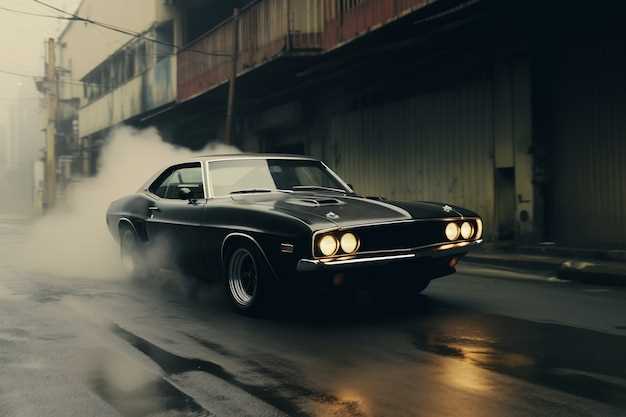
The world of muscle cars is rich with history, performance, and passion. Among the numerous iconic models, there are rare gems that deserve more attention than they currently receive. Muscle cars, known for their powerful engines and distinctive designs, are not just vehicles; they are symbols of American automotive culture. As enthusiasts seek to diversify their collections, some of these less-recognized models present remarkable opportunities that should not be overlooked.
Many car collectors focus on the preeminent names in the muscle car realm, but several rare options provide both excitement on the road and potential investment returns. These vehicles often embody unique features or limited production runs that set them apart from the mainstream crowd. Investing in these lesser-known muscle cars can lead to discovering new favorites while building a diverse portfolio.
As we explore the muscle cars that are currently flying under the radar, we will highlight rare finds that combine performance, style, and a solid legacy. Whether you’re a seasoned collector or a newcomer to the scene, these models foster a sense of nostalgia while offering thrilling driving experiences. Stay tuned as we delve into this fascinating world of muscle cars you shouldn’t overlook right now.
Top Rare Muscle Cars Worth Considering
When diving into the world of muscle cars, it’s easy to get swept away by the well-known icons. However, some rare gems are often overlooked that deserve your attention, both for their performance and collectability.
One standout option is the Plymouth Hemi Cuda. Produced in limited quantities, this powerful vehicle is famed for its aggressive styling and high-performance 426 Hemi engine. Its rarity makes it a sought-after collector’s item, ensuring that it holds value over time.
Another model to consider is the Chevrolet Camaro ZL1, specifically the first-generation from 1969. With only 69 units produced, this car features a massive 427 cubic inch engine and is a true piece of American automotive history, merging power with a distinctive design.
The Ford Mustang Boss 429 is also a noteworthy rare muscle car. Built for NASCAR homologation, only about 1,300 units were made in 1969, making it both powerful and highly collectible. Its unique features and raw performance make it a great option for enthusiasts.
Finally, don’t overlook the Dodge Challenger T/A. Produced in 1970, this limited-run model was designed for racing, featuring a special exhaust system and lightweight components. With its rarity and racing pedigree, the T/A is a fantastic addition for any serious muscle car enthusiast.
Considering these rare muscle cars not only enhances your collection but also offers the potential for value appreciation as their scarcity continues to rise.
What Makes a Muscle Car Underrated?

Several factors contribute to the classification of a muscle car as underrated. Firstly, performance often plays a critical role. Many muscle cars offer impressive horsepower and torque but lack the mainstream recognition of their more famous counterparts. For example, models that may not have achieved iconic status can still provide exhilarating driving experiences.
Secondly, pricing is a significant determinant. Some underrated muscle cars can be found at lower price points compared to their more celebrated brethren, making them appealing options for enthusiasts looking for value without sacrificing performance. These accessible price tags can lead to a strong following among collectors who appreciate the blend of affordability and power.
Design also influences how muscle cars are perceived. While some models boast standout aesthetics, others may not catch the eye as readily. Yet, this lack of visual flair can be misleading; a well-engineered muscle car with understated styling can offer an incredible driving experience that is often overlooked.
Moreover, brand loyalty can overshadow many excellent vehicles. Fans of specific manufacturers often direct their attention to traditional favorites, neglecting lesser-known models from other brands. As a result, these underrated cars may hold remarkable performance and ownership experiences that are not widely recognized.
Lastly, historical context plays a role in underestimation. Many muscle cars were produced during specific eras, and those from lesser-known manufacturers or with limited production runs may not have garnered the attention they deserve. As automotive trends shift, the appreciation for these vehicles can increase, making them intriguing options for collectors and enthusiasts alike.
Altogether, the combination of performance, pricing, design, brand loyalty, and historical context creates a landscape where certain muscle cars remain underrated, waiting for their moment in the spotlight.
Key Features of Sought-after Models

When it comes to classic muscle cars, several underrated models stand out due to their unique characteristics and driving experiences. These sought-after vehicles often possess features that make them appealing to collectors and enthusiasts alike. Below is an overview of some crucial features found in these muscle cars.
| Model | Engine Type | Horsepower | Weight | Price Range |
|---|---|---|---|---|
| Pontiac GTO | V8 | 360 hp | 3,500 lbs | $30,000 – $60,000 |
| Dodge Charger R/T | 5.7L HEMI V8 | 375 hp | 3,800 lbs | $40,000 – $70,000 |
| Ford Mustang Mach 1 | 4.6L V8 | 305 hp | 3,400 lbs | $25,000 – $55,000 |
| Chevrolet Nova SS | V8 | 350 hp | 3,200 lbs | $20,000 – $45,000 |
| Plymouth Road Runner | 383 ci V8 | 335 hp | 3,300 lbs | $30,000 – $65,000 |
These models are often underrated, having been overshadowed by more popular counterparts. However, their unique features, such as lightweight frames and powerful engines, make them significant in the muscle car landscape. Investing in these vehicles can not only provide an exhilarating driving experience but also promise potential future appreciation in value.
How to Find Hidden Gems in the Market
Finding underrated muscle cars can be quite rewarding for enthusiasts and collectors alike. While many focus on the most famous models, there are several strategies to uncover hidden gems that might not be on everyone’s radar.
- Research the Market:
- Study classic car forums and online communities dedicated to muscle cars.
- Follow auto shows and auctions to see what models gain attention.
- Read books and articles that highlight lesser-known muscle cars.
- Network with Car Enthusiasts:
- Join local car clubs and attend meetups to share knowledge and experience.
- Connect with seasoned collectors who may have insights into underrated models.
- Participate in online discussions to learn about hidden options.
- Inspect Online Listings:
- Check classified ads for lesser-known brands and models.
- Look for vehicles that have been sitting for a while, as they often represent better deals.
- Be vigilant for poorly worded listings; they can often hide valuable finds.
- Attend Specialty Auctions:
- Observe auctions that focus on niche collectors; these can yield surprising options.
- Look for models that may not have the best reputation but have strong specifications.
- Consider less popular auction houses that may feature underrated vehicles.
- Explore Non-Traditional Sources:
- Check out estate sales, as classic cars can sometimes be overlooked.
- Look at farm auctions, where vintage vehicles may go unnoticed.
- Search social media marketplaces for local sellers offering lesser-known muscle cars.
By employing these strategies, you can uncover underrated muscle cars that possess both aesthetic charm and driving excitement. Staying persistent and open-minded will lead you to hidden gems in the market.
Restoration vs. Original Condition: What to Choose?
When it comes to rare muscle cars, the decision between restoration and maintaining original condition is crucial. Each choice carries its own implications for value, aesthetics, and driving experience.
Restoration often means bringing a vehicle back to its former glory. This process can enhance the car’s appearance and functionality, making it more appealing to some enthusiasts. Restored vehicles may also attract buyers who prefer a car that looks and drives like new, even if it means sacrificing some originality. However, a fully restored muscle car can lose some of its value if it has been modified extensively or if replacement parts are not original.
In contrast, a car in original condition holds a unique charm for collectors and purists. These vehicles often showcase the manufacturing quality and imperfections of the era, which adds to their character. Rare muscle cars in original condition can command higher prices at auctions, especially if they come with documentation proving their authenticity. However, they may require more maintenance and may not perform at the level of a restored counterpart.
Ultimately, the choice between restoration and original condition depends on individual priorities. If the focus is on investment and potential appreciation in value, original cars are often favored. For those who seek a reliable and enjoyable driving experience, restoration may be preferable. Assess your passion and goals to determine the best route for your rare muscle car.
Understanding the Value Appreciation of Rare Models
The appreciation of value in rare muscle cars often stems from several key factors, including their production numbers, historical significance, and unique features. Many underrated models, which may have flown under the radar for years, are now commanding attention from collectors and enthusiasts alike. The rarity factor is instrumental; as fewer units remain in pristine condition, their desirability increases, rapidly boosting market value.
Historical Significance plays a crucial role in the value appreciation of these vehicles. Models that are linked to specific events, such as motorsport victories or iconic films, tend to attract a dedicated following. Enthusiasts often seek these cars not just for their performance but also for their stories and legacy.
Another aspect to consider is the uniqueness of features. Certain trims, engine options, or special packages can make a model stand out. Collectors often seek these unique attributes, which can greatly influence market demand. As a result, underrated models that offer distinctive specifications may see significant appreciation over time.
The automotive market has shifted, with many collectors moving towards preservation and restoration rather than mere usage. This has led to a surge in interest for models that were once overlooked, emphasizing the importance of understanding past trends in muscle car production. By studying these trends, investors can better gauge which underrated models are likely to appreciate.
In conclusion, while popular models often capture the spotlight, several rare muscle cars deserve recognition for their value potential. Those keen on expanding their collections should closely examine these underrated gems, as their appreciation prospects could yield substantial returns in the long run.




